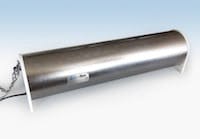It is said that water bodies, like human bodies, require good circulation to function properly. Quiescent waters in potable water storage tanks can cause problems such as thermal stratification, biofilms, excessive disinfection byproducts and disinfectant residual loss. Ice formation in distribution system reservoirs is another challenge for water utilities in northern climates during winters. Thick layers of ice often form at the surface in storage tanks during prolonged periods of subfreezing weather. The seams of steel tanks can expand during ice formation, causing structural damage and water leakage. The vertical movement of huge ice chunks with inflows and outflows may further damage the tanks.
Lyons, a rural community in central Michigan, faced the problems of icing every year since the potable water tank was built in 1972. According to Susan Craft, superintendent of the Department of Public Works, ice damage took out the tank’s cathodic protection. During the process of renovating and updating the single pedestal tank, Craft consulted with Dixon Eng. of Lake Odessa, Mich., on a solution to the problem, and in November 2012 installed a GridBee GS-12 mixer from Medora Corp. Craft reports there was no ice buildup in the tank that winter and, furthermore, that the effects of year-round mixing have significantly improved chlorine residual.
Passive Mixing is 'Old School'
Most potable water storage tanks were built before the water-quality benefits of circulation and mixing were fully appreciated. Tanks were designed with excess storage capacity for fire protection, adequate water pressure and future growth. Because of this excess capacity, daily usage was relatively small in relation to the size of the tank, which limited the benefits of passive mixing. Another limitation of passive mixing is that tanks were designed with single pipe influent-effluent designs, with the ingress-egress point typically located at the base of the tank.
Insufficient mixing enables water to become thermally stratified within the tanks. During subfreezing weather, temperatures in the lower portion of the water column are warmest because influent waters (typically about 11°C from a groundwater source) are the primary source of heat. When influent volumes are low, influent water temperature declines quickly to around 3°C to 5°C, and the new water stays in the lower portion of the water column because the density of water is greatest at about 4°C. Water temperatures in the tank decline with increasing elevation until ice forms wall-to-wall on the surface. Subsurface ice continues to form, often reaching thicknesses of 1 to 2 ft.
In Lyons, the tank’s 100,000-gal capacity further limited passive mixing. “Our tower was too small to lower the level much during the winter,” Craft said. “And because we use the height of the water for pressure, we need to keep it as full as possible. Plus, lowering the water level compromised fire flow capacity.” As a result, an “ice cake” formed in the tank.
Active Mixing Overcomes Problems of Horizontal Layers
Active mixing is based on the fact that water in potable water storage tanks naturally forms thin horizontal layers. The heaviest, or densest, layer is at the bottom, and each layer above it is progressively lighter. The job of an active mixer, such as the GridBee GS-12 that Craft installed, is to mix new inflow water throughout the entire water body. The GS-12 sets on the tank floor and pulls water in from 1 to 2 in. of the tank floor, pulling in water from the very bottom of the tank, where the densest layers are, and directly transporting it to the top of the tank. Soon, the temperature becomes nearly identical throughout the tank, and prevents ice from forming.
Craft uses the mixer year-round to combat problems from water stratification. Pulling water right off the tank floor ensures the most efficient mixing of important boundary layers—without disturbing the sediment—providing uniform distribution of disinfectant and uniform water age, as well as preventing stratification.
“I was able to keep the tank full during the winter with no icing problems, and the levels of chlorine residual have become more consistent," Craft said. "I was having differing chlorine residuals before I started mixing, but now it’s been even out in the system. One sample I pull from a dead end has maintained a really even residual.”
Keeping chlorine residual levels consistent requires less treatment, which helps the public works department reduce costs. And improving water quality is, of course, the ultimate goal for Lyons and its residents.
Michael Christensen is east U.S. manager for Medora Corp. Christensen can be reached at 970.484.3437.



